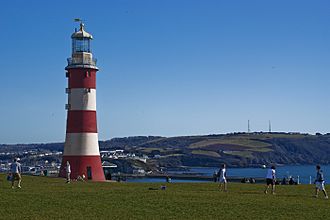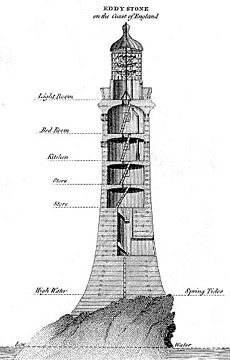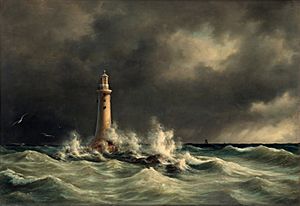Smeaton's Tower facts for kids
Quick facts for kids Smeaton's Tower |
|
|---|---|
 |
|
| General information | |
| Type | former lighthouse and memorial |
| Location | The Hoe, Plymouth, England |
| Coordinates | 50°21′52″N 4°08′31″W / 50.36441°N 4.14183°W |
| Completed | 1759 |
Smeaton's Tower is a famous old lighthouse that now stands as a memorial. It honors John Smeaton, a brilliant engineer who designed it. This lighthouse was a huge step forward in how lighthouses were built. It guided ships safely from 1759 to 1877.
The original lighthouse stood on the Eddystone Rocks, far out at sea. But over time, the rocks it was built on started to wear away. Because of this, the tower had to be taken down. Most of it was carefully moved and rebuilt on Plymouth Hoe in Plymouth, England. You can visit it there today!
Contents
History
Why a Lighthouse Was Needed
The coasts of England can be very dangerous for ships. The weather is often rough, and there are many hidden rocks. The Eddystone Rocks were especially risky. Ships could easily crash there.
People tried to build markers on these rocks before Smeaton's lighthouse. The first one, called the Winstanley Lighthouse, was destroyed in a big storm in 1703. Then, the Rudyard Lighthouse was built. Sadly, it was destroyed by fire in 1755. After two failures, a new, stronger lighthouse was desperately needed.
Meet John Smeaton
John Smeaton was born in 1724 in Austhorpe, England. He is known as the "father of civil engineering". This means he was one of the first people to use science to design and build things like bridges, canals, and lighthouses. He also made water wheels work much better.
After the second lighthouse was destroyed, experts suggested John Smeaton for the job. Designing the new Eddystone Lighthouse became his greatest achievement.
Building the Strong Lighthouse
Smeaton knew his lighthouse had to be super strong. It needed to survive powerful storms and crashing waves. He designed it to look like an oak tree, which is a very stable shape.
He also rediscovered an old Roman secret: a special type of concrete called hydraulic lime. This concrete could set and become hard even underwater! Smeaton used this concrete to put huge granite blocks together. He also used a clever method called dovetail joints and marble dowels. These made the stones fit together like puzzle pieces, making the tower incredibly solid.
Construction began in 1756. Smeaton set up a special workyard in Millbay. Here, workers prepared the large stones. They used special tracks and carts to move the heavy stones around. A ship called the Eddystone Boat carried the finished stones out to the rocks. The very first foundation stone was placed on June 12, 1756.
The lighthouse was finished in August 1759. It cost about £40,000, which was a lot of money back then! Many skilled miners from Cornwall helped build it. To make sure these workers were safe, the government made a special rule. They gave each worker a medal. This medal showed that they were working on the lighthouse and could not be forced to join the navy.
The lighthouse stood about 72 feet (22 meters) tall. It was 26 feet (8 meters) wide at its base and 17 feet (5 meters) wide at the top.
Life as a Lighthouse
The lighthouse's 24 candles were first lit on October 16, 1759. Each candle was quite large, weighing between 2 and 5 pounds. A special clock was placed next to the light. It would chime every 30 minutes. This reminded the lighthouse keeper to check and replace any candles that had burned out.
In 1810, the candles were replaced with brighter oil lamps and reflectors. More improvements were made in 1841. In 1845, an even better lamp and a special Fresnel lens were installed. This lens made the light much stronger and easier to see from far away.
The lighthouse kept working until 1877. That's when people noticed a problem: the rocks under the lighthouse were wearing away. Every time a big wave hit, the lighthouse would shake! It was no longer safe.
Becoming a Memorial
Smeaton's Tower stopped being a working lighthouse in February 1882. A new, even bigger lighthouse was being built nearby. The top part of Smeaton's Tower was then carefully taken apart. It was moved and rebuilt on a new base on Plymouth Hoe. This new spot was a popular public area. The tower became a memorial to John Smeaton.
The memorial was opened to the public on September 24, 1884.
The very bottom part of the old tower is still on the Eddystone Rocks. It was too strong to be taken apart, so it was left there next to the new lighthouse. Smeaton's lighthouse was so famous that it even appeared on the back of the British penny coin from 1860 to 1894!
There's also a replica of Smeaton's lighthouse, called Hoad Monument, built in 1850. It stands above the town of Ulverston in Cumbria.
In 1913, a homemade bomb was found at the entrance to Smeaton's Tower. It was part of the campaign for women's right to vote. Luckily, the wind blew out the fuse, and it didn't explode.
Smeaton's Tower has been a protected historic building since 1954. Today, visitors can climb 93 steps, including some steep ladders, to reach the top. From there, you can see amazing views of Plymouth Sound and the city.
On October 15, 2009, the tower's lantern was lit with 24 candles again. This celebrated 250 years since the lighthouse first shone its light.
In 2020, a granite statue of John Smeaton was placed inside the tower's lantern room. It was made by artist Philip Chatfield.
Gallery
See also
- List of lighthouses in England
- Grade I listed buildings in Plymouth












